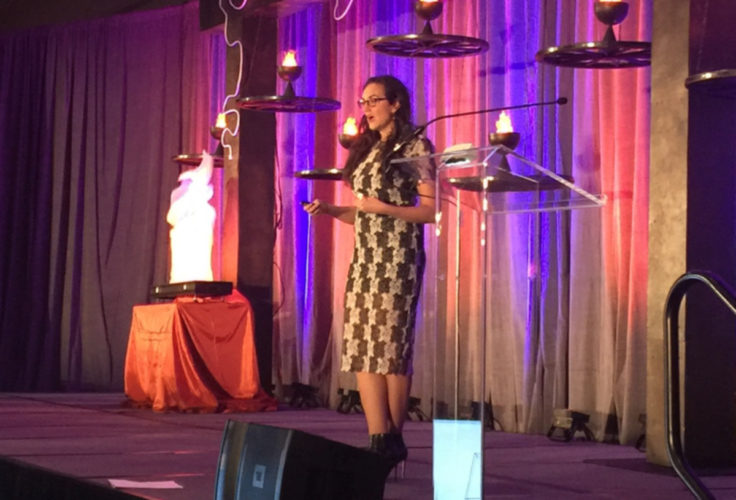As an alumna of Olin’s Executive MBA program, I was invited to attend this year’s 13th annual St. Louis Business Journal’s Women’s Conference on January 26. Although I had heard of Rent the Runway, I didn’t know anything about it until Jennifer Hyman, founder and CEO, gave the luncheon keynote.
Founded nine years ago with friend and fellow Harvard classmate Jennifer Fleiss, Hyman’s company has raised $190 million in venture capital funding. RTR earned $100 million in revenue in 2016. Its Series E round of $60 million that year was among the largest ever for a woman-run company.
Hyman’s message epitomizes why I love going to this conference. She talked about her idea, why it works, how it has grown, and emphasized that if she can do it, anyone can. This conference highlights successful women who want to share their stories and help other women achieve their goals.
The overall business case for RTR is compelling. In an economy where we rent everything from cars (Uber) to bedrooms (Airbnb), renting clothing makes sense. RTR grew from the concept that for special occasions in particular, women are willing to spend more than they can afford on designer clothes they won’t wear more than once.
By offering rentals of special outfits at a fraction of the cost, RTR makes high-ticket items accessible to a wider audience. The company has expanded the concept beyond special occasions to everyday fashion.
Hyman’s experience and advice applies to anyone in business, but especially to entrepreneurs. Here are the tips that caught my attention:
If she can do it, you can do it
A self-deprecating and funny Hyman explained the very basic actions she took to start her business. Hyman conceived of her idea when her younger sister bought a dress for a special event that cost more than her rent. Hyman and Fleiss brainstormed, which led to the $190 million question: “What if we could rent dresses?”
From there, they pursued an in-person, five-minute meeting with the most influential fashion icon they could think of—Diane von Furstenberg—and cold-emailed her by trying different combinations of her initials and name, until one of the attempted addresses made it through.
You don’t have to have it 100 percent figured out
Hyman and Fleiss did not have their business model worked out when they met with von Furstenberg. “We didn’t know what we were doing when we walked into her office,” Hyman said. “We just threw on von Furstenberg dresses and did it.”
They came up with the name “Rent the Runway” on the spot and pitched the idea. “I think entrepreneurs sometimes make the mistake of being secretive about their ideas, trying to get it all worked out before talking to people about it,” Hyman said.
Instead, Hyman and Fleiss could form their business plan based on conversations they had with the people they talked to about it.
If the answer is no, ask why
“By the way, she hated the idea,” Hyman said. von Furstenberg initially resisted the premise that renting clothes could be profitable, but the conversation continued. By asking questions about the resistance von Furstenberg had, Hyman learned that the von Furstenberg brand appealed mostly to women in their 50s and 60s, but that their marketing targeted a younger demographic.
The five-minute meeting extended to two hours. Hyman said the other designers with whom RTR now has great working relationships were also resistant at first. By keeping the lines of communication open, Hyman continued pursuing the conversations.
People at the top don’t always have the best ideas
At the end of their two-hour meeting with von Furstenberg, Hyman and Fleiss asked for the names of two or three other industry people they could talk to. “It’s the people on the front lines who know the most about the business,” Hyman said. Talking to von Furstenberg was a foot in the door, but great ideas can be mined among lower-level people.
Never stop dreaming bigger
With success in special occasion rentals, RTR could have continued to grow. Hyman kept pushing, however, for expanding the reach of the “Cinderella moment.”
“Women grow up believing that the only day they will feel like Cinderella is on their wedding day,” Hyman said. Believing this didn’t need to be the case, she came up with a subscription concept that would allow women to rent and exchange items for a monthly fee.
Your alma mater can be your calling card
It’s interesting to consider why von Furstenberg took the meeting with Fleiss and Hyman. As Hyman tells it, their email to her was a one liner: “We are two Harvard business students with an idea and could we have five minutes of your time?”
Whatever her reasons, you can’t underestimate the impact of their academic credentials. In my experience, in St. Louis, a reference to Washington University can and does have a significant impact.
I’m in an older demographic than RTR’s target market—20-somethings who value wearing and being photographed regularly in a wide variety of high-end clothes.
I also wear plus sizes, which, though available on the website, are not offered in great numbers. If Hyman is thinking about this additional area of growth—older, larger women seeking Cinderella moments—I look forward to becoming a subscriber.



